Blue-eyed and light-haired beauty Chrissie White (1895-1989) was one of the most famous stars of the British silent cinema. In 1907 the 12-years old started at the Hepworth company and soon became a popular child star. In the 1920s, she and husband Henry Edwards were regarded as one of Britain's most newsworthy celebrity couples.
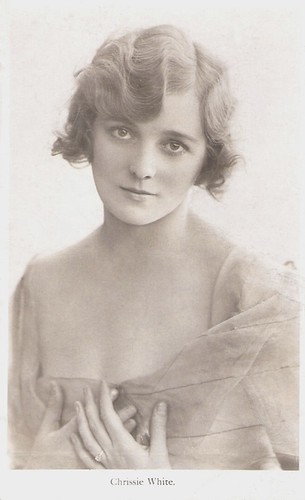
British postcard. Photo: Hepworth Pictures.
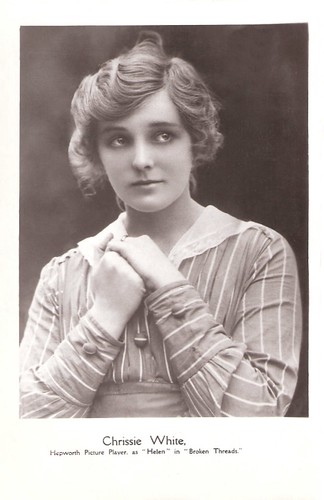
British postcard. Photo: Hepworth Pictures. Publicity still for Broken Threads (Henry Edwards, 1917).
Chrissie White was born Ada Constance White in Chiswick, London, in 1895 – the year film was introduced by the Lumière brothers. As a child, she made her first stage appearance in Bluebell in Fairyland.
She started her film career when joining the Hepworth company in 1907, when she substituted for her sister, Gwen. Another sister, Rosina White also worked for Hepworth.
Ada was 12 at the time and under the name of ‘Chrissie’ she soon became one of the first stars of the British cinema. She often performed in shorts by director Lewin Fitzhamon, such as The Cabman's Good Fairy (Lewin Fitzhamon, 1909).
When White was teamed with Alma Taylor, they became a popular comic duo as the naughty schoolgirls Tilly (Taylor) and Sally (White), who create havoc everywhere.
The Tilly girls featured in a popular series of comedies in the years 1910 and 1911. Typical examples are Tilly the Tomboy Visits the Poor (Lewin Fitzhamon, 1910) and Tilly's Party (Lewin Fitzhamon, 1911). Although she was a star now, White always rode to the studios on a bicycle.
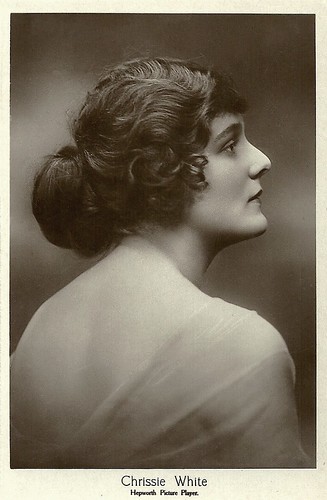
British postcard by Hepworth.
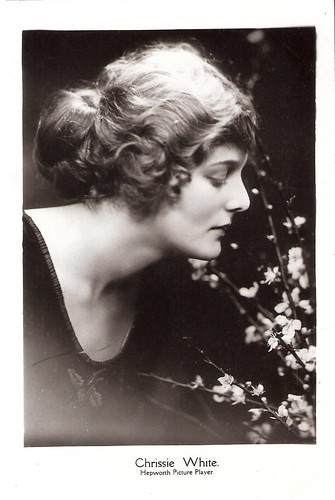
British postcard. Photo: Hepworth Pictures.
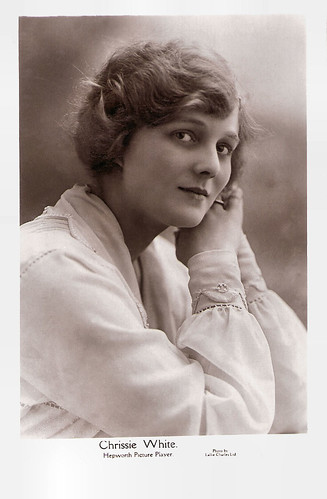
British postcard by Hepworth Pictures. Photo Lallie Charles.
Chrissie White moved slowly from comedy to drama and romance. By 1912 she had become Hepworth’s leading lady and the blue-eyed beauty was the most popular British star of her time. In the same year she married Claude Whitten, who also worked for Hepworth.
One of her earliest features was a crime film set in the horse racing milieu: Kissing Cup (1913, Jack Hulcup). This film still survives in the Desmet Collection at the Eye Film Institute in Amsterdam, as well as the Tilly comedy Tilly in a Boarding House (1911).
Other memorable titles were The Vicar of Wakefield (Frank Wilson, 1913) with Violet Hopson, and At the Foot of the Scaffold (1913, Warwick Buckland) opposite Alec Worcester.
Among Chrissie White’s other male film partners were Lionelle Howard (from 1914 on), Stewart Rome (between 1914-1917), a.o. in Coward! (1915, Frank Wilson) and Her Boy (Frank Wilson, 1915), and Henry Edwards (from 1918 on).
Edwards also directed most of their films together, such as Possession (Henry Edwards, 1919), The City of Beautiful Nonsense (Henry Edwards, 1919), The Kinsman (Henry Edwards, 1919), The Bargain (Henry Edwards, 1921) and Lily of the Alley (Henry Edwards, 1923).
All in all they did some 22 films together. They were also a couple in real life, as White married Edwards in 1922. Edwards and White became real celebrities in Britain, the equivalent of Douglas Fairbanks and Mary Pickford.
White's last silent film with Edwards was the romance The World of Wonderful Reality (Henry Edwards, 1924). When Hepworth collapsed in 1924, Chrissie White - who had worked only for Hepworth - retired from the screen, to the regret of her fans.
She returned briefly in the sound era to play in two more films with Edwards as her male partner: The Call of the Sea (Leslie Hiscott, 1930) and the comedy General John Regan (Henry Edwards, 1933), filmed in Northern Ireland. White definitively retired from the screen, and after the death of Edwards in 1952 she withdrew completely from publicity. She had worked in over 180 films, shorts and features.
At the age of 94, Chrissie White died of a heart attack in Liss, Hampshire, England, in 1989. She was buried at the Westwood Memorial Park. Actress Henryetta Edwards (1926) is her daughter. Clips of Chrissie White's films can be traced in the BBC / BFI documentary Silent Britain (2006).
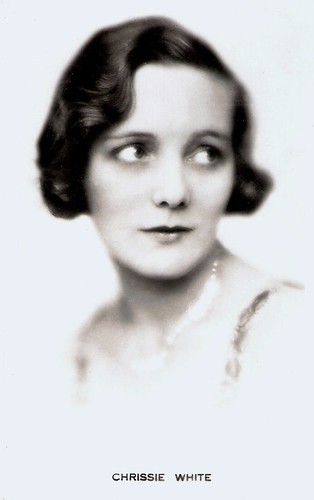
British postcard by T.I.C.
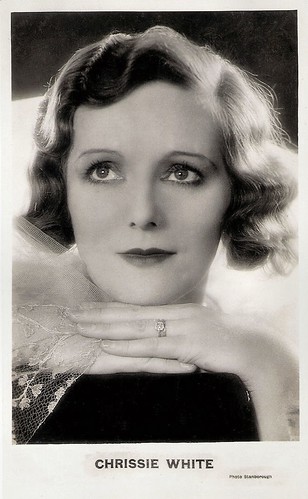
British postcard. Photo: Stanborough.
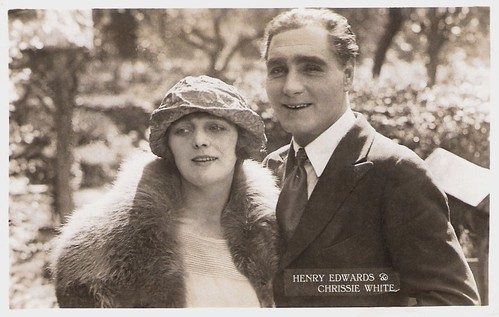
With Henry Edwards. British postcard by TIC.
Sources: David Quinlan (IMDb), Hepworthfilm.org, Wikipedia, and IMDb.

British postcard. Photo: Hepworth Pictures.

British postcard. Photo: Hepworth Pictures. Publicity still for Broken Threads (Henry Edwards, 1917).
Creating Havoc Everywhere
Chrissie White was born Ada Constance White in Chiswick, London, in 1895 – the year film was introduced by the Lumière brothers. As a child, she made her first stage appearance in Bluebell in Fairyland.
She started her film career when joining the Hepworth company in 1907, when she substituted for her sister, Gwen. Another sister, Rosina White also worked for Hepworth.
Ada was 12 at the time and under the name of ‘Chrissie’ she soon became one of the first stars of the British cinema. She often performed in shorts by director Lewin Fitzhamon, such as The Cabman's Good Fairy (Lewin Fitzhamon, 1909).
When White was teamed with Alma Taylor, they became a popular comic duo as the naughty schoolgirls Tilly (Taylor) and Sally (White), who create havoc everywhere.
The Tilly girls featured in a popular series of comedies in the years 1910 and 1911. Typical examples are Tilly the Tomboy Visits the Poor (Lewin Fitzhamon, 1910) and Tilly's Party (Lewin Fitzhamon, 1911). Although she was a star now, White always rode to the studios on a bicycle.

British postcard by Hepworth.

British postcard. Photo: Hepworth Pictures.

British postcard by Hepworth Pictures. Photo Lallie Charles.
Most Popular British Star of Her Time
Chrissie White moved slowly from comedy to drama and romance. By 1912 she had become Hepworth’s leading lady and the blue-eyed beauty was the most popular British star of her time. In the same year she married Claude Whitten, who also worked for Hepworth.
One of her earliest features was a crime film set in the horse racing milieu: Kissing Cup (1913, Jack Hulcup). This film still survives in the Desmet Collection at the Eye Film Institute in Amsterdam, as well as the Tilly comedy Tilly in a Boarding House (1911).
Other memorable titles were The Vicar of Wakefield (Frank Wilson, 1913) with Violet Hopson, and At the Foot of the Scaffold (1913, Warwick Buckland) opposite Alec Worcester.
Among Chrissie White’s other male film partners were Lionelle Howard (from 1914 on), Stewart Rome (between 1914-1917), a.o. in Coward! (1915, Frank Wilson) and Her Boy (Frank Wilson, 1915), and Henry Edwards (from 1918 on).
Edwards also directed most of their films together, such as Possession (Henry Edwards, 1919), The City of Beautiful Nonsense (Henry Edwards, 1919), The Kinsman (Henry Edwards, 1919), The Bargain (Henry Edwards, 1921) and Lily of the Alley (Henry Edwards, 1923).
All in all they did some 22 films together. They were also a couple in real life, as White married Edwards in 1922. Edwards and White became real celebrities in Britain, the equivalent of Douglas Fairbanks and Mary Pickford.
White's last silent film with Edwards was the romance The World of Wonderful Reality (Henry Edwards, 1924). When Hepworth collapsed in 1924, Chrissie White - who had worked only for Hepworth - retired from the screen, to the regret of her fans.
She returned briefly in the sound era to play in two more films with Edwards as her male partner: The Call of the Sea (Leslie Hiscott, 1930) and the comedy General John Regan (Henry Edwards, 1933), filmed in Northern Ireland. White definitively retired from the screen, and after the death of Edwards in 1952 she withdrew completely from publicity. She had worked in over 180 films, shorts and features.
At the age of 94, Chrissie White died of a heart attack in Liss, Hampshire, England, in 1989. She was buried at the Westwood Memorial Park. Actress Henryetta Edwards (1926) is her daughter. Clips of Chrissie White's films can be traced in the BBC / BFI documentary Silent Britain (2006).

British postcard by T.I.C.

British postcard. Photo: Stanborough.

With Henry Edwards. British postcard by TIC.
Sources: David Quinlan (IMDb), Hepworthfilm.org, Wikipedia, and IMDb.
2 comments:
Your blog is getting better. I'm always here.
Greetings
O Falcão Maltês
I haven't commented in a while, but I do love reading these bios. I learn so much here. Love silent films, so enjoyed reading about Chrissie White. New to me.
Post a Comment